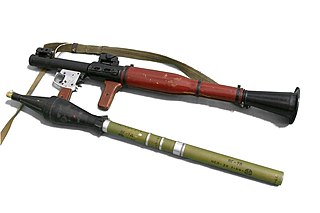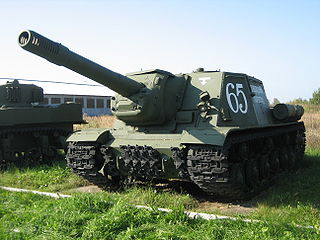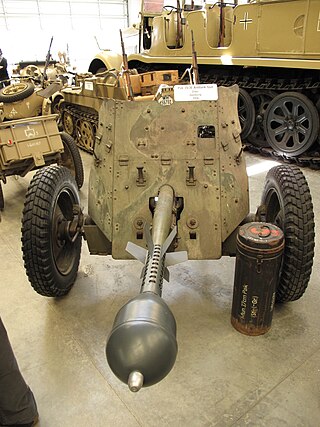
A rocket-propelled grenade (RPG) is a shoulder-fired rocket weapon that launches rockets equipped with an explosive warhead. Most RPGs can be carried by an individual soldier, and are frequently used as anti-tank weapons. These warheads are affixed to a rocket motor which propels the RPG towards the target and they are stabilized in flight with fins. Some types of RPG are reloadable with new rocket-propelled grenades, while others are single-use. RPGs are generally loaded from the front.

Armour-piercing ammunition (AP) is a type of projectile designed to penetrate armour protection, most often including naval armour, body armour, and vehicle armour.

The 8.8 cm KwK 43 was an 88 mm 71-calibre-length tank gun designed by Krupp and used by the German Wehrmacht during the Second World War. It was mounted as the primary armament on the Panzerkampfwagen VI Ausf. B Tiger II. The 8.8 cm Pak 43, an anti-tank gun, was very similar in design but mounted on tank destroyers or deployed stand-alone on the field.

High-explosive anti-tank (HEAT) is the effect of a shaped charge explosive that uses the Munroe effect to penetrate heavy armor. The warhead functions by having an explosive charge collapse a metal liner inside the warhead into a high-velocity shaped charge jet; this is capable of penetrating armor steel to a depth of seven or more times the diameter of the charge. The shaped charge jet armor penetration effect is purely kinetic in nature; the round has no explosive or incendiary effect on the armor.

The Panzerfaust was a development family of single-shot man-portable anti-tank systems developed by Nazi Germany during World War II. The weapons were the first single-use light anti-tank weapons based on a pre-loaded disposable launch tube, a weapon configuration which is still used today.

Panzerschreck was the popular name for the Raketenpanzerbüchse 54, an 88 mm reusable anti-tank rocket launcher developed by Nazi Germany in World War II. Another earlier, official name was Ofenrohr.

The ISU-152 is a Soviet self-propelled gun developed and used during World War II. It was unofficially nicknamed Zveroboy in response to several large German tanks and guns coming into service, including Tigers and Panthers. Since the ISU-152's gun was mounted in a casemate, aiming it was awkward, and had to be done by repositioning the entire vehicle using the tracks. Therefore, it was used as mobile artillery to support more mobile infantry and armor attacks. It continued service into the 1970s and was used in several campaigns and countries.

In anti-tank warfare, an anti-tank mine is a type of land mine designed to damage or destroy vehicles including tanks and armored fighting vehicles.
The Panzerfaust 3 is a modern semi-disposable recoilless anti-tank weapon, which was developed between 1978 and 1985 and first entered service with the Bundeswehr in 1987. It was first ordered in 1973 to provide West German infantry with an effective weapon against contemporary Soviet armor, thereby replacing West Germany's aging PzF 44 Light Lanze launchers and the heavy Carl Gustaf 84 mm anti-tank recoilless rifle manufactured in Sweden.
The following is a list of ammunition fired by the 125 mm smoothbore gun series used in the T-64, T-72, T-80, M-84, T-90, PT-91, T-14 Armata, and other tanks derived from those designs, as well as the 2A45 Sprut anti-tank gun.

RKG-3 is a series of Soviet anti-tank hand grenades. It superseded the RPG-43, RPG-40 and RPG-6 series, entering service in 1950. It was widely used in the 1973 Arab–Israeli War and remained a common weapon into the 2000s and early 2010s, being favoured by Iraqi insurgents during the American-led occupation. Modified versions of the RKG-3 series have also emerged in the Russian invasion of Ukraine.

The Pak 36 is a 3.7 cm / 37mm caliber German anti-tank gun used during the Second World War. It was the main anti-tank weapon of Wehrmacht Panzerjäger units until 1942. Developed by Rheinmetall in 1933, it was first issued to the German Army in 1936, with 9,120 being available by the beginning of the war in September 1939 and a further 5,339 produced during the war. As the predominant anti-tank gun design in the world during the late 1930s, demand was high for the Pak 36, with another 6,000 examples produced for export and the design being copied by the Soviet Union as the 45 mm anti-tank gun M1932 (19-K) and by other nations such as Japan.

Armour with two or more plates spaced a distance apart falls under the category of spaced armour. Spaced armour can be sloped or unsloped. When sloped, it reduces the penetrating power of bullets and solid shot, as after penetrating each plate projectiles tend to tumble, deflect, deform, or disintegrate; spaced armour that is not sloped is generally designed to provide protection from explosive projectiles, which detonate before reaching the primary armour. Spaced armour is used on military vehicles such as tanks and combat bulldozers. In a less common application, it is used in some spacecraft that use Whipple shields.

The AT2 mine is a scatterable anti-tank mine developed by Dynamit Nobel. It can be scattered from artillery rockets or from mine laying systems, and is in service with the British, German and Norwegian armed forces. AT2 mines were donated to Ukraine by Germany.

The Panzerwurfmine was a shaped charge hand-thrown anti-tank grenade used by Luftwaffe ground troops in World War II.

The Stielgranate 41 was a German shaped charge, fin-stabilized shell, used with the 3.7 cm Pak 36 anti-tank gun to give it better anti-tank performance.

Man-portable anti-tank systems are traditionally portable shoulder-launched projectile systems firing heavy shell-type projectiles, typically designed to combat protected targets, such as armoured vehicles, field fortifications and at times even low-flying aircraft.

The Type 3 "anti-tank" hand grenade is a Japanese grenade produced from 1943 to 1945 during World War II. It was designed to destroy the Allies' tanks. There are three variants (sub-types) of the weapon: Ko, Otsu, and Hei.

The Shitotsubakurai or lunge mine was a suicidal anti-tank weapon developed and used by the Empire of Japan during the Second World War. It used a HEAT type charge. This weapon was used by the CQC units of the Imperial Japanese Army. The weapon itself was a conical hollow charge anti-tank mine, placed inside a metallic container and attached to the end of a wooden stick. The weapon was officially adopted by the Japanese Army in 1945; in that year it caused its first victims in the Pacific Theater, where it commonly saw action against American armour. Later that year, some Japanese Imperial Army manuals of the weapon were discovered by US troops.

The Gewehr-Granatpatrone 40 or GGP/40 for short was a shaped charge rifle grenade used by German forces during the Second World War. It was originally developed for Luftwaffe Fallschirmjäger units to provide them with a light and portable anti-tank weapon.


















